How we use notebooking and loop scheduling for middle school.
I originally created the Loop Book for my now 11yo son, Tank*, who was desiring more independence in his homeschool routines. He liked the idea of Fun-Schooling, but the journals weren’t resonating with him. While extremely creative, Tank’s creativity comes with an engineering and rhythmical mind: he prefers clear, general guidance, consistency, and clean lines.
You can read more about our journey to creating the Loop Book here, but for the purpose of this blog post, I’d like to show you how it works for our current 6th grader**.
*I use pseudonyms on this site to protect my children’s privacy. Hopefully that’s obvious. 😉
**We don’t actually refer to or think much about grade levels in our homeschool. The public school calendar is irrelevant to us, and our focus is more about forward progress than arbitrary beginnings and endings. Each of our kids is functioning at multiple grade levels depending on the subject area or skill, which is to be expected of most kids. But for the purpose of blogging simplicity, I’m assuming Tank is in 6th grade.
This post may contain affiliate links, which means I receive a small commission, at no extra cost to you, if you make a purchase using my links. I only share links to items that we use and love! Please see my disclosure for more details.

Finding Focus
My kids have a lot of ownership over their schooling. I try to involve them as much as possible in decision-making, so I ask for their input often. We revise and evolve our homeschooling methods and routines frequently. It is a never-ending evolution!
That said, I do have boxes in my mind that I want to check. These boxes look a little different for each kid. The boxes you want to check will look different than mine, and likely different for each of your kids, too! Ah, the wonderful flexibility of homeschooling!
Depending on the state (or country) in which you live, you may have different rules regarding the subjects you are required to teach and/or document. How we approach these subjects, however, will vary depending on each child’s interests and natural abilities!
Middle school years are a time of tremendous growth and maturing, so finding what ignites your kids’ interests can feel a bit like throwing spaghetti at the wall and seeing what sticks. If you aren’t sure where your kids’ interests lie, or how to use those interests, or you don’t think your kid has any interests at all…then focus on their natural abilities. Their strengths.
I love that Julie Bogart, author of The Brave Learner, tells us to focus on growing our kids’ strengths (rather than hammering away at their weaknesses). As she explains in Getting to Know the Child in Your Child, “Strengths can compensate for weaknesses, whereas focus on weakness can undermine the sense of competence that is inherent in the strength.”
Tank’s strengths are drumming, understanding strategy (sports, board games), reading, mathematical problem solving, engineering concepts, and deep diving to learn all about whatever topic he is currently passionate about. I realize that I kind of hit the jackpot for my oldest to be a problem-solving, passionate reader. But this same concept of focusing on strengths also works for my VERY different other kids! Which I’ll get to in later posts. 😉
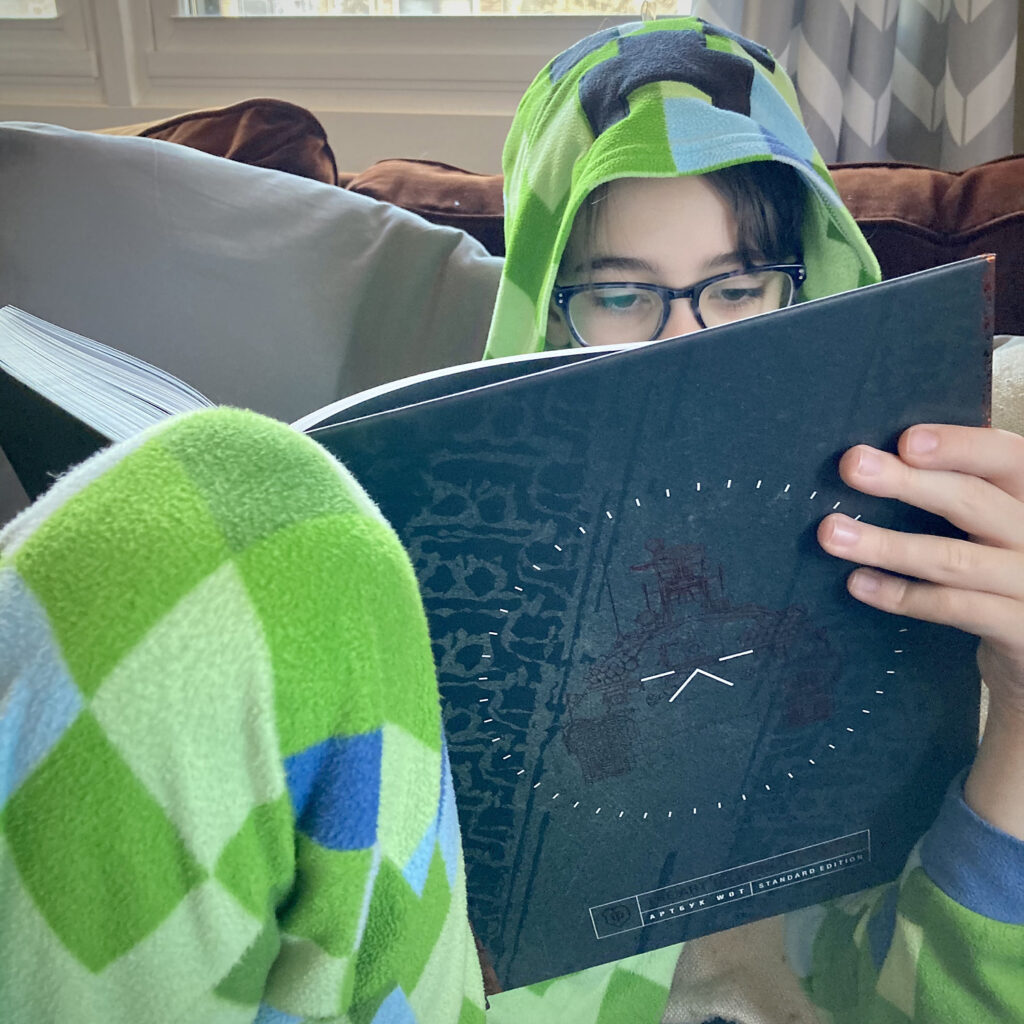
Back to finding focus.
The general method for the middle school years seems to be to cast a wide net, and then to pull it in to see what we’ve caught! In the elementary years, we often focus on skill building (reading, writing, math). In middle school, while we continue to build on those skills, we also want our kids to begin using those skills to learn more about world, about what they love, about how it all connects.
So if we want our kids to mature and grow, they need to start gaining more independence in their studies, as well. You can begin by encouraging them to focus on their interests and strengths.
Enter the Loop Book
Using the Loop Book, I can be confident that my son is hitting all of the core subjects (and more!) on a weekly basis. But I can also be confident that he is interested in what he is reading, watching, and learning! He gets to gain control over his education by finding out on his own what sparks his curiosity. I basically play the role of librarian, helping him find quality resources that appeal to his interests and strengths.
(If you’re mainly here to see pictures of completed pages, go ahead and jump to the photos! 😉)
Step 1
The first step in creating a Loop Book is to make a list of subjects or tasks you want your child to do weekly. We use a separate program for math, so that is not listed here.
My list for Tank:
- Reading or Spelling/Vocabulary
- Grammar
- Social Studies
- Creative Time (art or Minecraft design)
- Geography
- Current Events
- Science
- Science Experiment
- History
- LEGO design (he aspires to work for LEGO someday)
- Creative Writing
- Nature Study
Step 2
The next step is to choose which pages will best get these subjects/tasks completed! This is where Tank gets a lot of input. We go through the pages together to find which are his favorites. He liked a couple of different pages for some subjects, so he actually has a 2-week Loop Book, where some pages repeat, but others change for the second week. Below details (possibly excessively) what his weeks look like.
Week One:
- Read & Record – He can read anything that interests him, and record anything he found interesting by writing in his own words or doing copywork.
- Grammar – He reads from one of his grammar books or does a section of Khan Academy grammar, then records something he has learned by both writing and drawing.
- Social Studies – He reads a social studies related resource, then records something he has learned by both writing and drawing.
- Art – This is a very open-ended page. Usually he draws detailed, realistic tanks, because he is obsessed with tanks.
- Geography – He usually watches Geography Now! on YouTube, then finds the country on the map, records something interesting he learned, and draws the country’s flag.
- News – He likes having the prompts for the 5W’s +H, and he usually reads The Week Junior magazine for this page.
- Science – He reads a science related book, then records something he has learned by both writing and drawing.
- Experiment – He likes the page with no prompts because his experiments tend to be quite varied. Sometimes he thinks up his own experiment to try. Other times he will read about or watch an experiment and record what he learned.
- Biography – This is one way we get in a little extra history. Tank isn’t thrilled about doing the biography pages, but he does enjoy reading short biographies (like the Who Was series, or Usborne’s The Extraordinary Life series). He likes the pages with the prompts, as those help guide him to find the important information about each person.
- LEGO Challenge – He requested this page, and also requested that I find “real” LEGO graph paper (which is different from regular graph paper!). He’s quite serious about his LEGO aspirations.
- Writing – This is a full length page for free-writing. Usually it’s a silly story involving tanks or LEGO. Seeing a theme, here?
- Nature Study – This is also a very open-ended page, and Tank’s favorite. He asked that I put it as the last page each week (even though he can do the pages in any order he wants to) because it is his favorite page, and he usually saves it for last.
Week Two:
- Spelling & Vocabulary – Tank likes to find random interesting words from our favorite student dictionary (perfect for middle school!) to learn about for this page.
- Grammar (same as previous week)
- Social Studies (same as previous week)
- Minecraft Challenge – I’ve requested that Tank use this page to design something related to anything he’s been learning about. Sometimes the connection is VERY loose. 😉 But I’ll take it. He really enjoys making the plans and then seeing how they work out in actuality in the game.
- Geography (same as previous week)
- News (same as previous week)
- Science (same as previous week)
- Science Experiment (same as previous week)
- Design a Comic – I ask Tank to use this page specifically for the history we listen to together (Story of the World) as a way to solidify some of what he’s learned that week. He’s a pencil & stick figures kind of artist when it comes to these, but they are often quite comical!
- LEGO Challenge (same as previous week)
- Write & Draw – Also for free-writing but this week with less writing space and a box for adding an illustration.
- Nature Study (same as previous week)
Whew! That’s truly the hardest part. 😉 Step 3 is the “set it and forget it” part! I comb-bind Tank’s 2-week Loop Book along the top, which is how he prefers it as a lefty. He also recently asked me to put the second week facing inward, so he can just flip the book over and work “backwards” for week two. That’s working great!
What does it look like?
So what does his book end up looking like at the end of the week? I will preface these photos by saying that Tank is a pencil kind of guy. He does love to color when the mood strikes him, but for the most part, he prefers to write and draw in pencil only. While his sister Daisy* does just about ALL of her work in various colors of gel pen, and needs to sharpen her colored pencils at least once a week, Tank just prefers that good ol’ grey. I’m not going to begrudge him his practicality.
So while these pages may not be colorful, neatly printed showcases of perfection, I don’t ever EXPECT them to be! I hope this realistic representation of an 11 year old boy’s work resonates with you. 😉
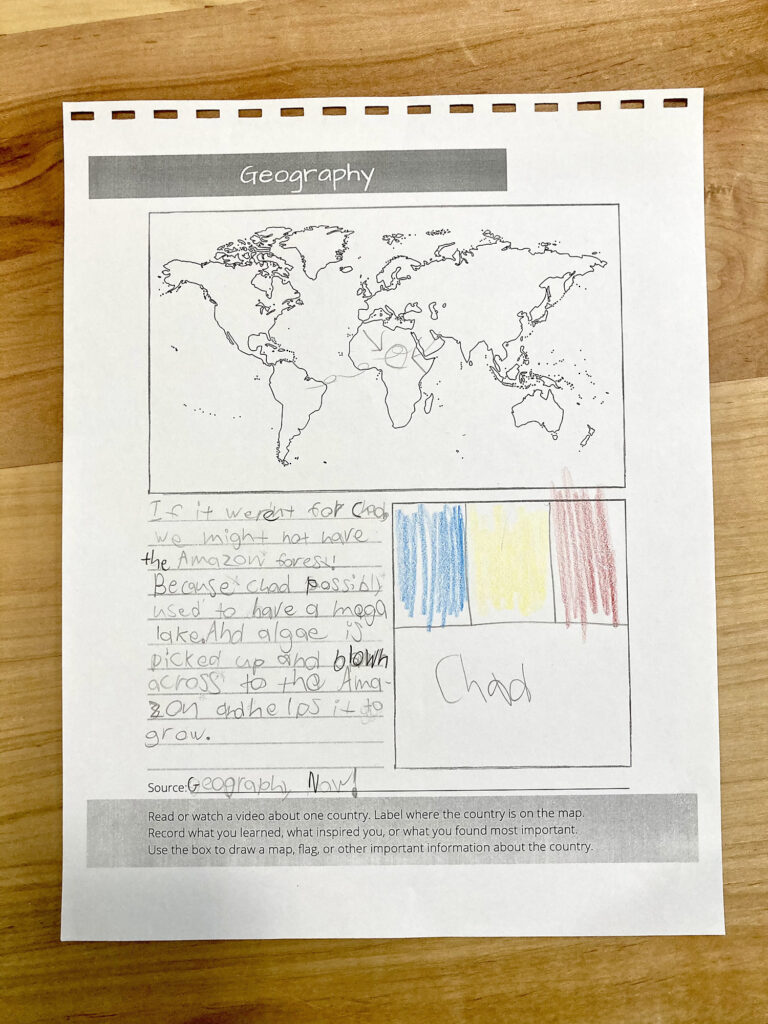
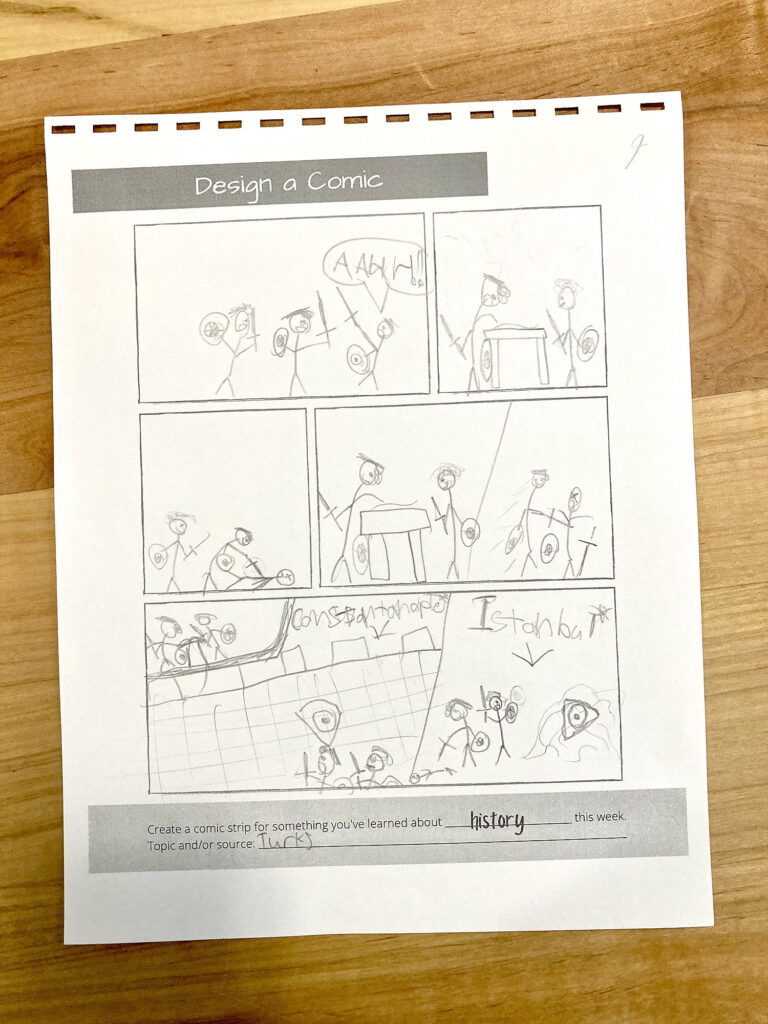
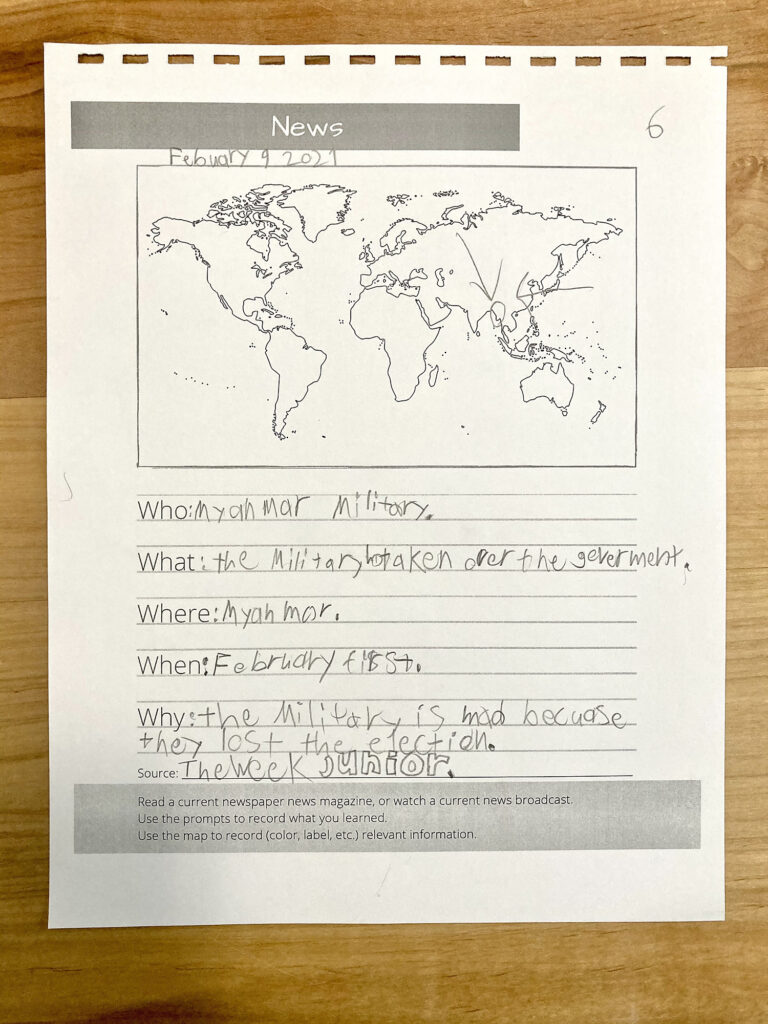
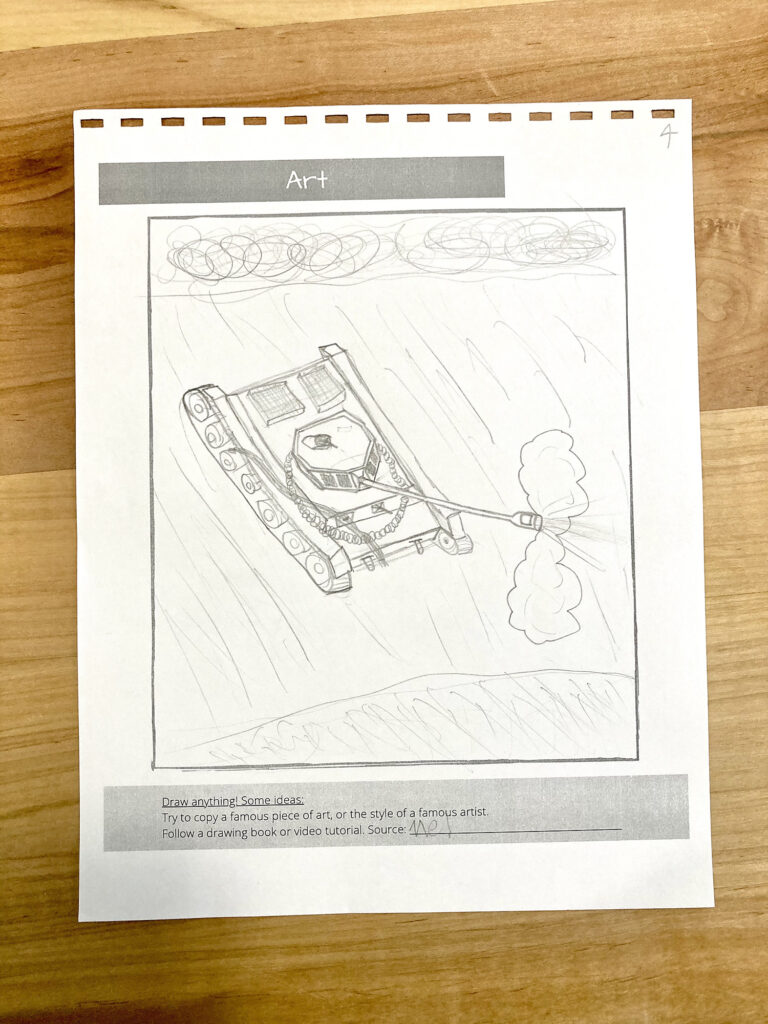
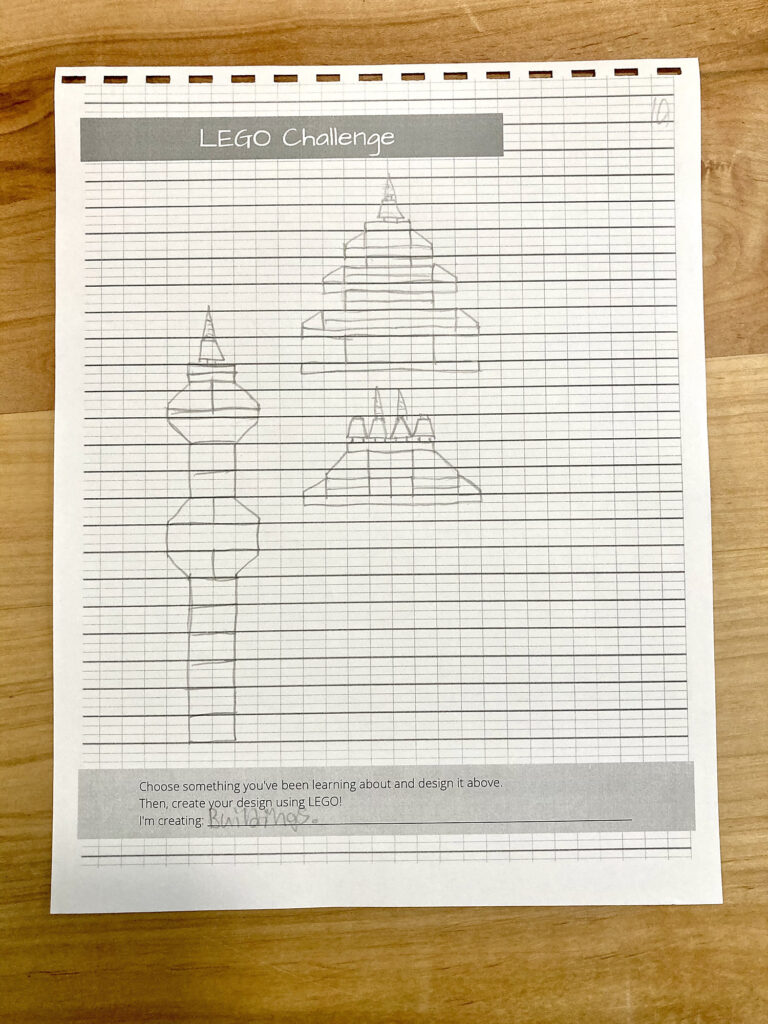
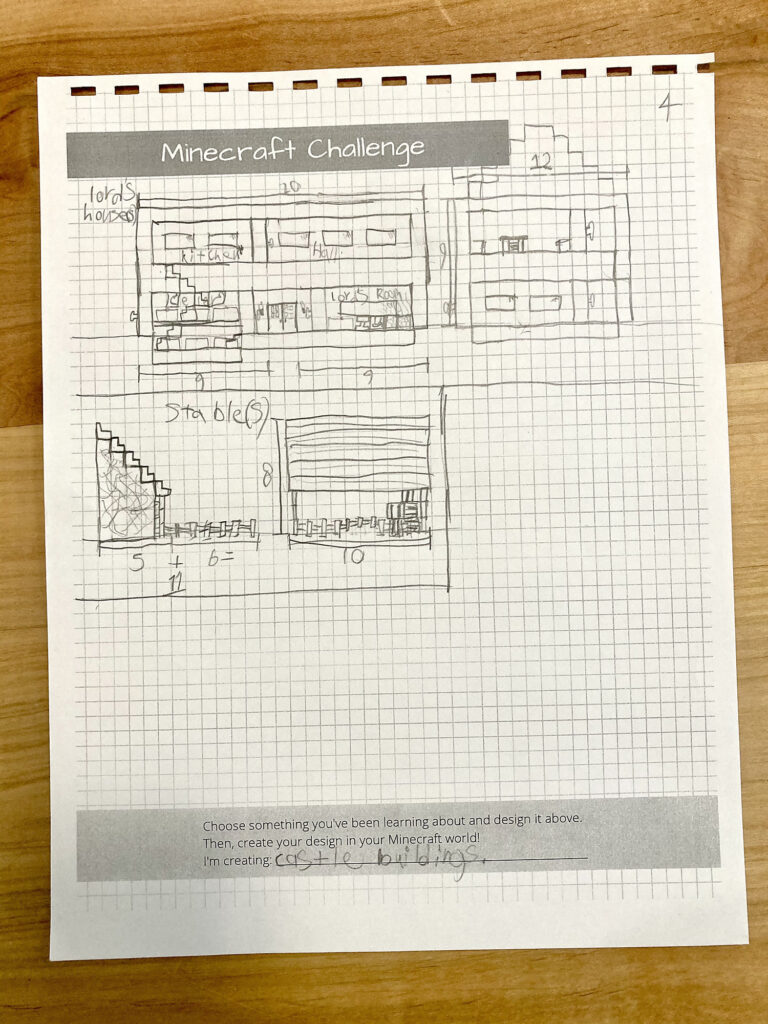
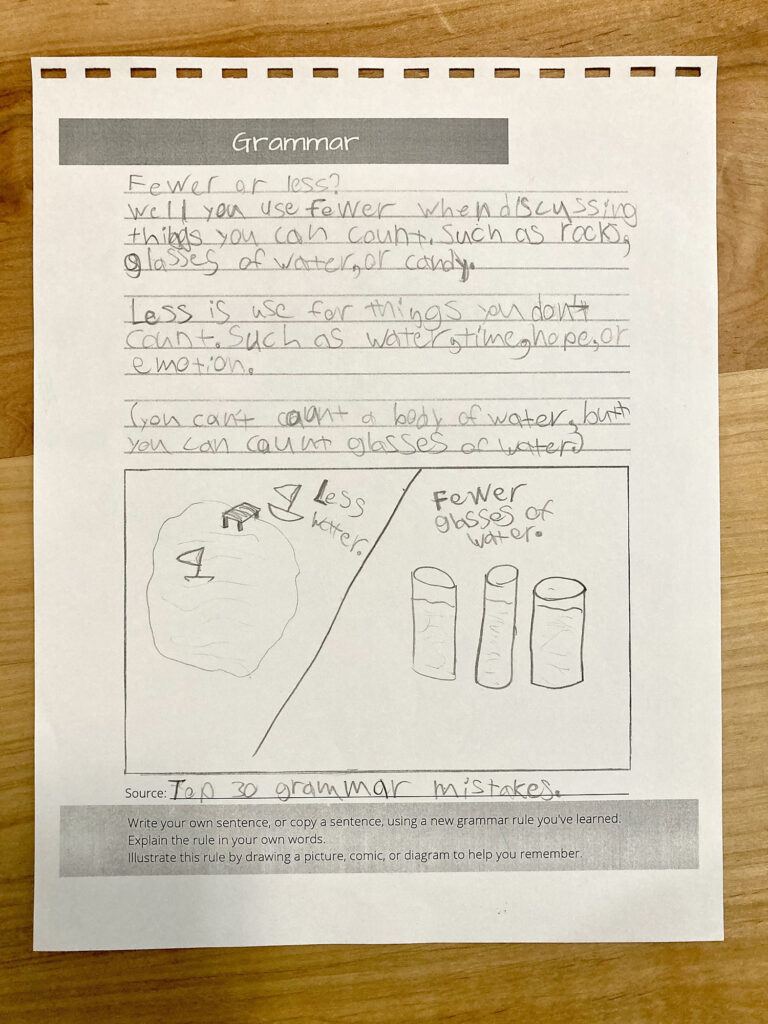
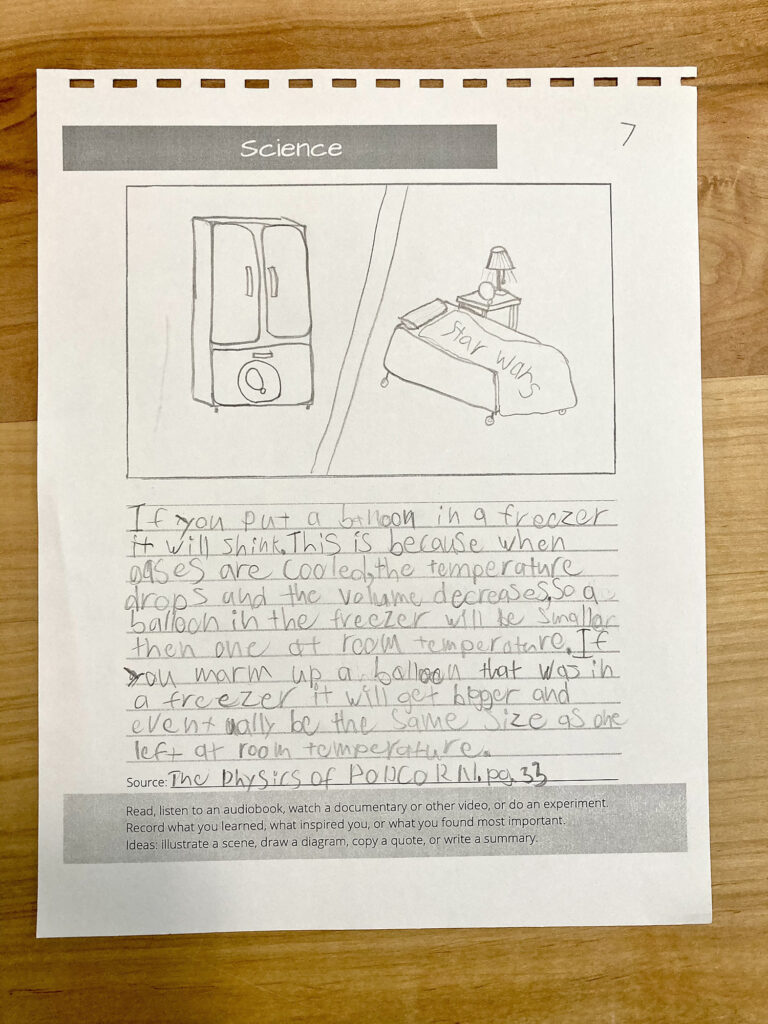
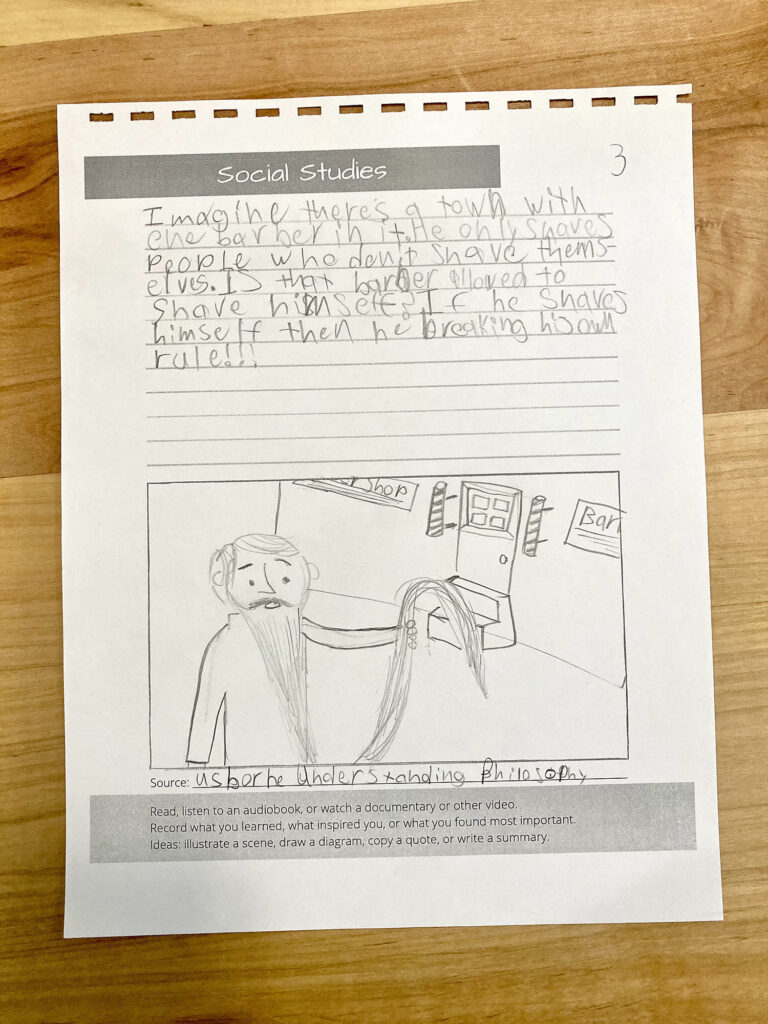
Evaluation
Tank usually prefers to do most of his pages alone in his bed, by book light, after bedtime. It’s quiet, and I think he is able to concentrate better. He’s also a night owl (like his mom), and this gives him the opportunity to make quality use of his night owl tendencies! If he isn’t working on his Loop Book after bedtime, he is usually reading ridiculous amounts of fiction, which I also totally count as “school.”
Throughout the week, I touch base with Tank to see how he is progressing through his Loop Book. He usually ends up proudly bringing his completed pages to show me, so that he can tell me about all the interesting things he has been learning (or get me to read one of his super silly stories from his free-writing! ☺️).
At the end of each week, we go over all of Tank’s completed pages together. I get to explore what he has found interesting throughout the week, and we have some great discussions! This is where he gets to expand on what he has learned beyond what he has written. We also discuss any expectations that might need adjusting, like if he has forgotten to list his sources, or if he needs to put more effort into legible handwriting.
The awesome asterisk.
The “spelling asterisk” is a quirk that Tank began doing years ago, and it just sort of stuck. Now his younger sister, Daisy, also does it! Whenever he writes a word for which he’s uncertain about the spelling, he puts an asterisk by it. When we go through his Loop Book pages together, I will show him the correct spelling of those words (if needed).
These are usually the only words I correct (unless we see some funny mistakes). Since he is motivated to improve the spelling of those particular words, the corrections seem to stick a lot better than if I just went through and red-penned ALL of his spelling errors. We’re loving this method thus far! (Side note: he also works on spelling through his typing program, Touch Type Read & Spell, which we highly recommend!)
As for grammar or punctuation mistakes, I only point them out in his Loop Book if they alter the meaning of a sentence, or if I notice the mistake repeatedly. I try to choose just one or two things to explain when we’re reviewing his work, and I think that having those concepts explained within the context of what he has written truly helps him internalize the WHY behind the rules. This not only helps him to remember, but also gives him reason to want to remember (to clarify his writing).
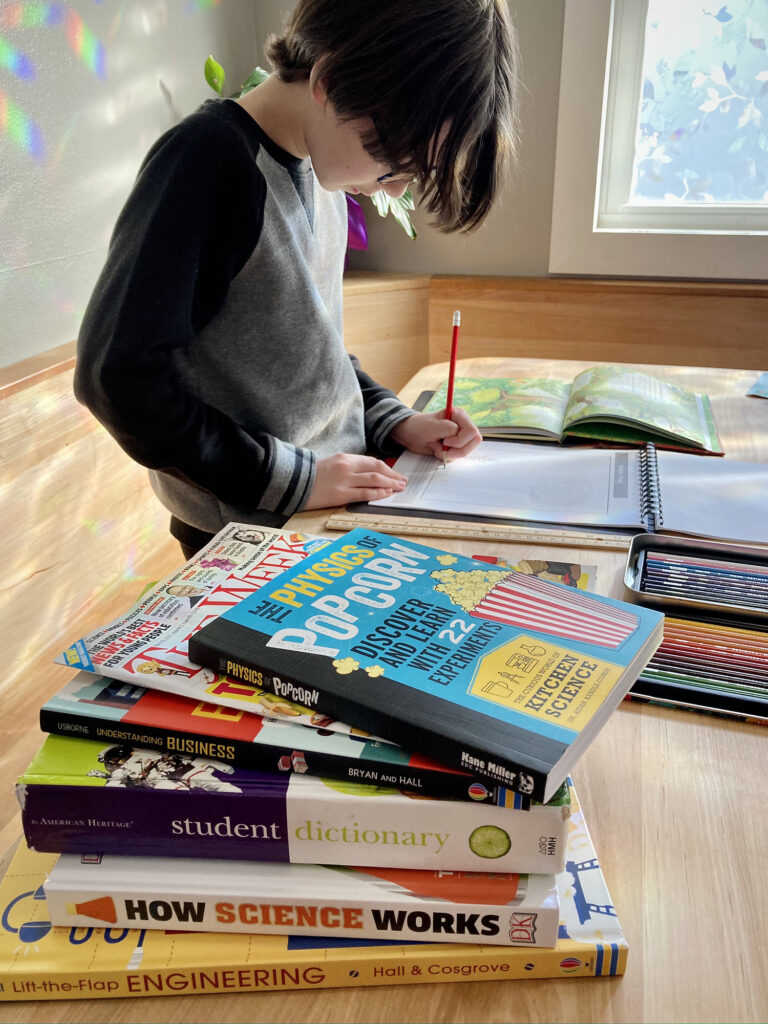
Whew! I hope this was a helpful explanation of just one way the Loop Book can work for middle school! Resources matter, of course, and I plan to share more of our favorite middle school resources in a separate post soon! For now, what questions do you have? Could you see your middle schooler finding independence and joy through Loop Booking?
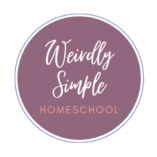
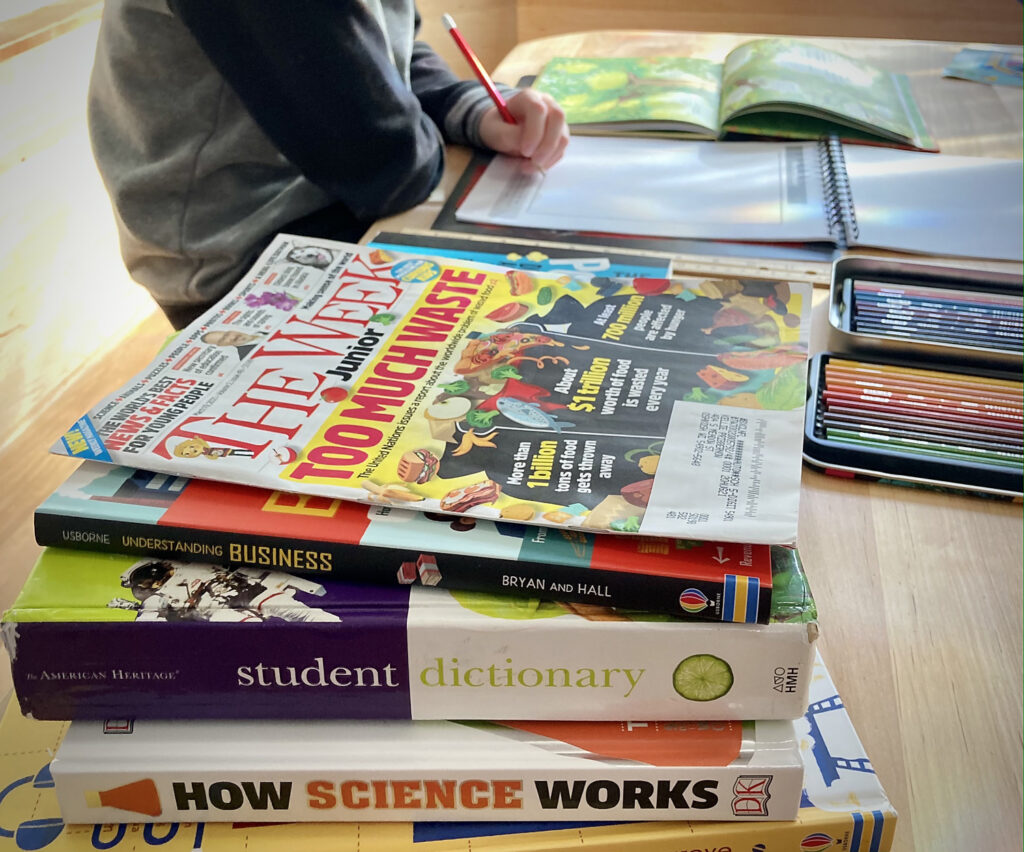
Your articles about loop schedules & loop books clearly explained the process. Thank you for taking the time to share them! I am curious to know whether or not you think this would work for a high schooler.
Thank you so much for the encouragement! 🙂
I do think this method could work well for a high schooler, with adjusted expectations and resources. Especially if you need to document credit hours for high school transcripts, but don’t want to be tied down to a curriculum. For example, if a course credit requires 120 hours (for a full credit, or year-long course), and your high schooler typically spends about one hour completing a history Loop Book page (including reading or watching a video, and taking notes and drawing), you could divide that up and know that he/she should do a history Loop Book page 3 times each week. That would complete the course in 40 weeks (you can adjust, of course, as needed, but that gives a general guideline). Resources would be especially important for high school, but that’s something that will depend a lot on each individual kid, and also on your state’s requirements (for example, you might be required to teach specific history courses, like Modern World History or American History, etc.). But finding appropriate resources is the fun part, for me! 😉 And the Loop Book pages are flexible enough to be useful for any topic.
I should add that my hope for my own kids is that using the Loop Book will help them transition into general, unguided note-taking. I’m hoping that at some point in high school, they are able to use the formats and ideas from the Loop Book to create their own note-taking styles, and take ample and useful notes on whatever it is they are learning (including drawing diagrams, or whatever else they find helpful for their particular learning styles). I think the Loop Book is a really helpful tool for transitioning into note-taking in, for example, composition notebooks.
Thanks so much for all of your feedback & helpful ideas!